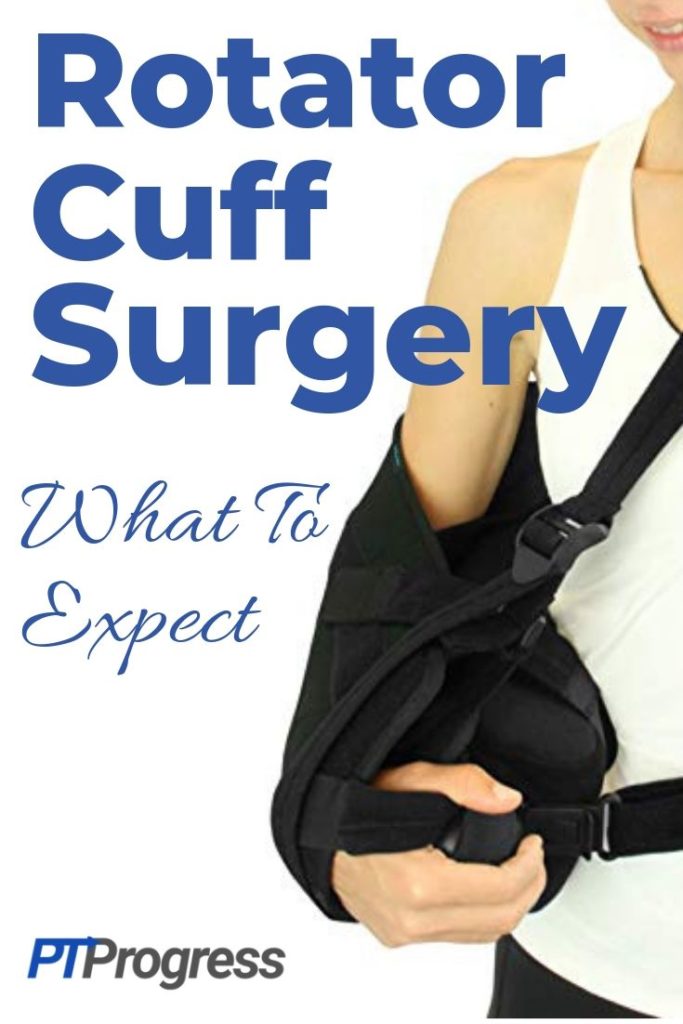
One of the most common shoulder surgeries is a rotator cuff repair. Whether you’re scheduled to have a rotator cuff surgery or you just had one, this article gives you a physical therapist’s perspective on what to expect after a rotator cuff surgery.
What is the Rotator Cuff?
There are four different muscles that stabilize the ball and socket that make up the shoulder joint. These muscles are responsible for arm movement and shoulder stability. Through repeated heavy lifting, incorrect posture the tendons which attach muscles to bone may injure and tear.
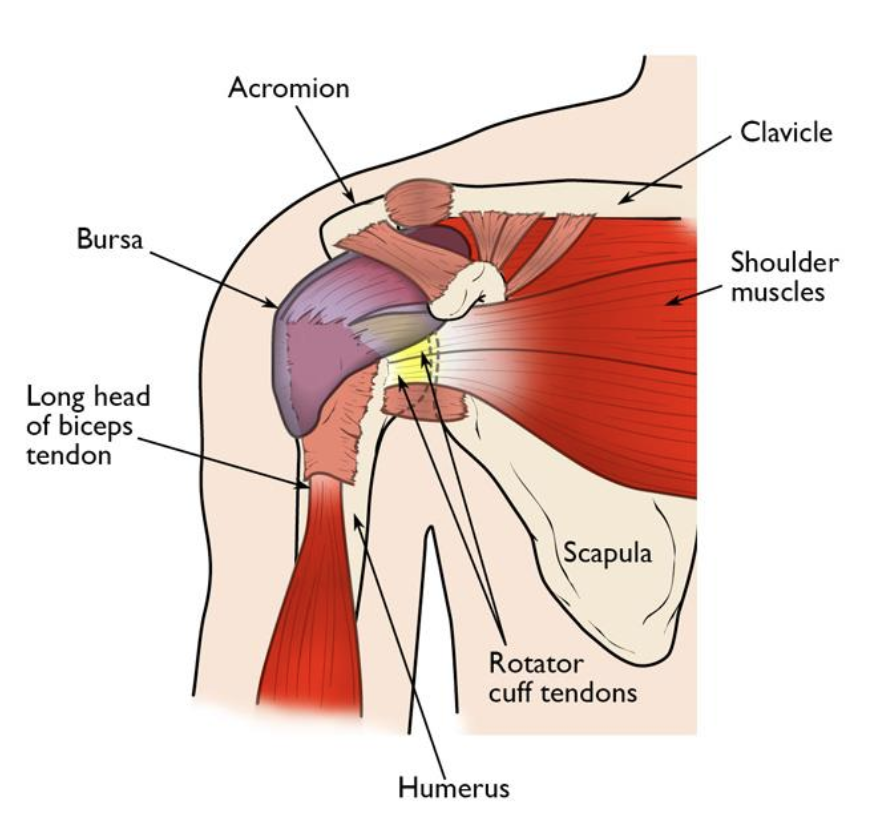
[Image: https://orthoinfo.aaos.org/globalassets/figures/a00406f01.jpg]
How do I know if I have a rotator cuff injury?
People who experience rotator cuff tears typically experience a deep ache in the upper arm (some describe it as like a “toothache” in the arm) that can radiate to the section of the arm to the elbow.
Torn Rotator Cuff Signs and symptoms include:
- Pain and weakness with overhead movements
- Pain with putting on and taking off clothes
- Pain with reaching behind the back when showering
- Pain with lying on the painful shoulder
- Difficulty performing physical activity or even job duties
What Does a Rotator Cuff Tear Feel Like?
It’s not uncommon for people with a rotator cuff tear to feel the following:
- Increased pain in the shoulder with lifting or during overhead activities.
- Inability to fully lift arm due to weakness of the shoulder muscles.
- Pain in the shoulder at night, keeping them from sleeping
- Pinching, catching, or popping sounds in the shoulder with movement
- Restricted range of motion, especially with reaching behind the back or overhead
There are several different clinical tests that Medical Doctors and Physical Therapists can perform to determine with certain confidence that a person has a rotator cuff tear. Rotator cuff tendon tears are ultimately confirmed through Magnetic Resonance Imaging (MRI) which Doctors prescribe.
Not all shoulder pain is a result from a rotator cuff tear. Likewise, you may have a rotator cuff tear and not experience any shoulder pain.
Multiple studies have been done showing that many people with rotator cuff repairs may not have symptoms. (here and here)However, it is common to see decreased shoulder function with a rotator cuff tear.
What does the Rotator Cuff Surgery Entail?
A rotator cuff repair is a surgery to restore the muscle tendon attachment to the humeral head (the ball of the ball and socket shoulder joint). It is most often done today through an arthroscopic technique – small incisions around the shoulder. The operation is now a same-day procedure with patients going home without hospital stays overnight.
How long does it take to recover from a Rotator Cuff Repair?
Rotator cuff repair requires a rehabilitation process of 9 months up to 1 year for the repaired tendon to be completely integrated into the body. The main goals are to restore pain-free shoulder movement, stability, and strength. Most people undergoing the surgery will follow-up with their surgeons for the first several months and go to Physical Therapy.
Is A Rotator Cuff Surgery Right For Everyone?
Not everyone with a rotator cuff tear will require surgery. The time and effort it takes to recover from rotator cuff repair surgery needs to be a serious consideration. Some surgeons will choose to send patients through conservative treatment first (i.e. rest and prevent heavy lifting and/or go to Physical Therapy for 4 to 6 weeks).
After trying non-surgical management, some may get better and do not need to have the operation. On the other hand, some rotator cuff injuries are serious and the limitations prevent the person from working, performing daily chores, or return to sport. In these cases of a serious rotator cuff injury, people may go the surgical route.
Initial Rehab: Sling use
- SUPPORT FOR ARM AND SHOULDER: Provides comfortable support while immobilizing the shoulder following surgery or injury, including shoulder...
- CONTOURED PILLOW: Removable dense foam cushion provides 15 degrees of abduction for optimal support. The abduction pillow is contoured to fit the body...
This sling includes an abductor pillow, which is more comfortable for most patients. Ask your surgeon if you can use a brace like this.
After surgery, patients will take home a sling used to protect the arm and the newly repaired tendons. Patients need to wear the sling for the first 6 weeks even during sleep. Patients may take the sling off when bathing or performing physical therapy exercises.
Shoulder Rehab for the First 6 weeks
The rehab process for a rotator cuff surgery is a long process of 9 to 12 months. This is where Physical Therapy will be vital to facilitate recovery and provide the best guidance.
For the first 6 weeks, patients need to refrain from any aggressive movement or weight lifting. Initial Physical Therapy sessions are very important for preventing injury and for gradual restoration of movement. In the first several sessions, the therapist will perform the arm movements for the patient (passive motion) so as not to strain any of the repaired muscles and tendons.
Here a list of DON’Ts for the first 6 weeks:
- Don’t lift your surgical arm overhead without help
- Don’t reach behind your back
- Don’t pick up any heavy objects with the surgical arm
- Don’t push or pull any objects with the surgical arm
- Don’t perform any chores or physical labor requiring the use of your surgical arm
Pain Management After Shoulder Surgery
Most patients with rotator cuff repair will have some level physical discomfort. The pain could be sharp when first attempting to move the arm. To address pain, most surgeons prescribe medication. Consult with your doctor or surgeon if symptoms continue or increase despite taking pain medication. Also be sure to let them know about side effects including nausea or lightheadedness.
Ice often
- PREMIUM MADE REUSABLE ICE PACK OR HOT PACK: Experience the iReliev Hot & Cold Therapy Gel Pack, a premium and reusable solution for soothing pain and...
- FREEZABLE * MICROWAVEABLE * REUSABLE: Stays flexible to mold firmly to injuries, knee, back, ankle, shoulder etc. for targeted hot or cold compress...
Ice is helpful to reduce inflammation and improve pain in the initial recovery process. Place an ice pack or cold compress over the shoulder for up to 20 minutes several times a day especially when recovering the first few weeks
Rotator Cuff Exercises for Weeks 1 – 6
These exercises are commonly performed after a rotator cuff repair. Consult with your surgeon and physical therapist before performing any exercise as your timeline may be slightly different. These sample exercises are to give you an idea of a common progression of rotator cuff exercises after shoulder surgery.
Pendulums

- Brace against a supportive surface (like a kitchen counter or dining table)
- Allow the surgical arm to hang down with just the weight of the arm
- Move your body back by bending your knees until the arm begins to swing around passively
- Go clockwise, then counterclockwise
- Perform 2 sets of 20 repetitions
Table Slides

- Rest your hand and forearm on a towel placed in front of your dining table
- Lean forward with your body and allow your arm to move forward until you feel a gentle stretch and hold at the end for 5 to 10 seconds
- Keep your shoulders relaxed, do not shrug your shoulders
- Perform 3 sets 10 reps
Shoulder Flexion passive range of motion

- Lie on your back
- Using the strength of your non-surgical arm, bring your surgical arm overhead, hold at the end for 5 to 10 seconds
- Keep your shoulders relaxed, do not shrug your shoulders
- Perform 3 sets 10 reps
Shoulder External Rotation passive range of motion
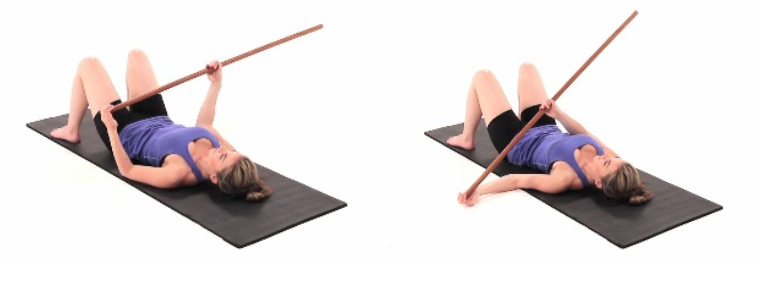
- Lie on your back, with your surgical arm’s elbow by your side
- Hold a lightweight stick with both hands
- Using the strength of your non-surgical arm, rotate your surgical arm outwards into a gentle stretch
- Hold at the end for 5 to 10 seconds
- Keep your shoulders relaxed, and keep your elbow by your side
- Perform 3 sets 10 reps
Shoulder Exercises week 1 – 6
Your physical therapist may also direct you to work on improving your wrist/elbow and grip strength so long as it is gentle for the shoulder joint.
Rehab 6 to 12 weeks post-op
Most patients will discontinue wearing the sling after week 5 to 6. This will also be the time in which patients will begin moving the arm, first with some help (therapists call this “active assistive” range of motion), then progressing independence with movement (“active”). There may be continued shoulder stiffness and so working gently through the range of motion bit by bit is key.
Shoulder Exercise for Weeks 6 to 8
Active Assistive Exercises (Flexion, Abduction, External Rotation)
The goal is to gradually get your surgical shoulder to move WITH HELP from your other arm.
- With both hands, hold onto a stick
- Using the help of the good arm, push your surgical hand:
- Straight up and forward (flexion)
- Up to the side (abduction)
- With your elbow by your side, rotate the arm (external rotation)
- When first starting, use your good arm to push most of the weight, then gradually do more with the surgical arm granted there is no pain
- Perform 3 sets 10 reps 5 second holds
Flexion with stick
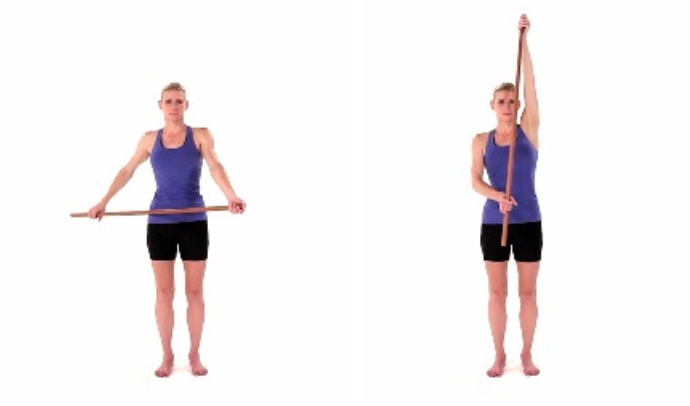
Abduction with Stick
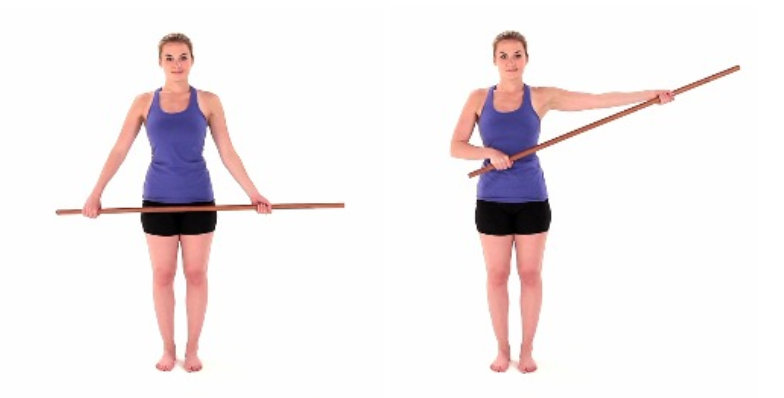
External Rotation with Stick
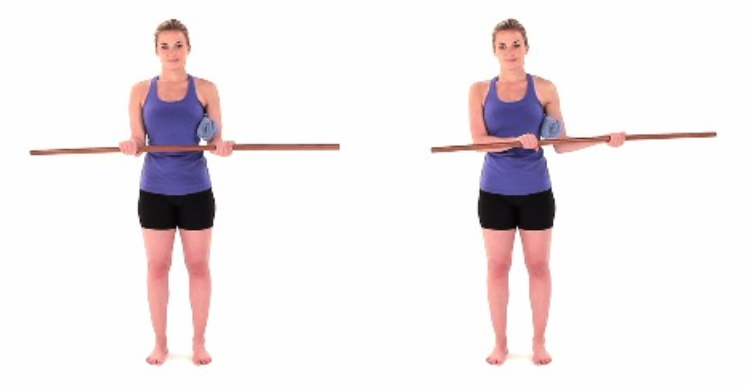
Isometrics
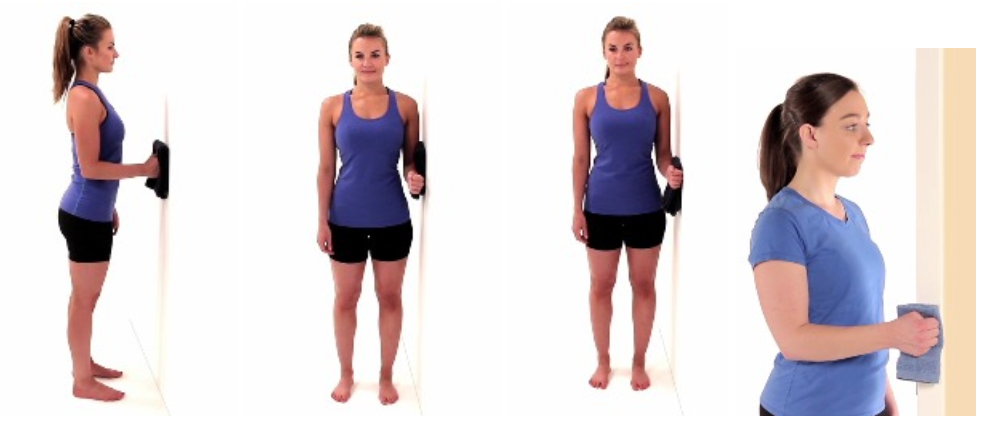
- With your elbow by your side, press a towel with your fist into the wall in each of these directions gradually until muscle activation is felt in the shoulder
- Perform 3 sets 10 reps 5-second hold
Shoulder Exercises Week 8 to 12
Resisted Shoulder External and Internal Rotation
External Rotation
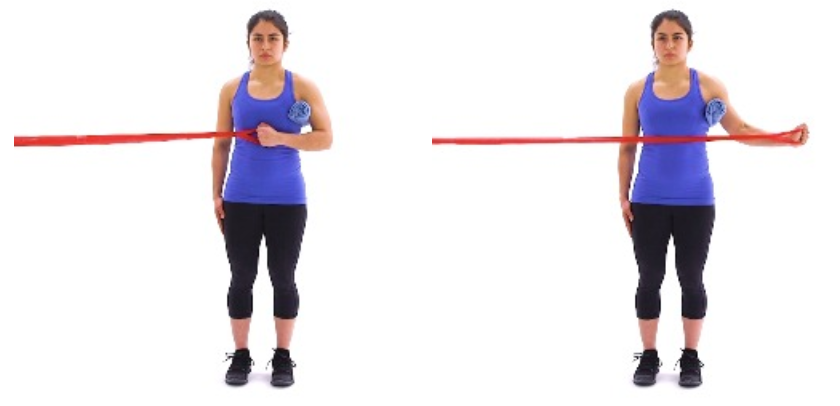
Shoulder Internal Rotation
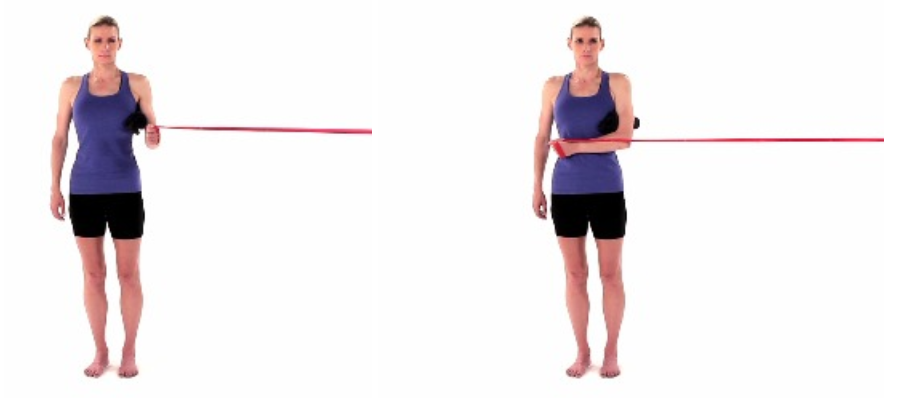
- Stand with your elbow to your side and hold onto a resistance band
- External Rotation: take the resistance band and rotate the arm outwards
- Internal Rotation: take the resistance band and rotate the arm towards your center
- Gradually progress resistance, discontinue or decrease resistance if you feel shoulder irritation
- Perform 3 sets 10 to 15 reps
Other typical exercises performed during weeks 8-12
- Bicep curls
- Tricep extensions
- Wrist flexor/extensor curls
- Resisted shoulder extension
- Resisted cable row pulls
- Straight elbow planks on an elevated counter
- Push-up plus from wall
- Wall slides
- Resisted internal/external rotation at 90 degrees of shoulder abduction
Shoulder Rehab 12 weeks post-op
About 3 months or 12 weeks after surgery, patients should be able to raise their arm on their own and be able to lift lightweight objects up to 5 pounds. Exercises past the 12 weeks should be gradually progressed with consideration of how the shoulder feels. Patients should still have routine follow-ups with a physical therapist to determine the intensity of the exercise.
The strengthening program going forward should focus on movements for returning to job duties and previous active hobbies. Even if shoulder pain has mostly subsided, the tendons still need time to heal. Patience is key.
Things to watch out for after surgery
Some pain and inflammation are normal for routine healing. However, some things may be concerning and require further attention from your surgeon. Watch out for:
- Active drainage or pus from the wound after 3 weeks, the incision sites should be closed by this point.
- Swelling and stiffness in the hand/wrist/elbow – this may mean that you have some limited lymphatic drainage; try elevating the arm on some pillows when you sit and performing some hand/finger exercises
- Severe unresolved pain in the shoulder joint after 6 weeks
Returning to Work After Rotator Cuff Repair
Most rotator cuff repair patients will expect to be off of work for several weeks. People who have a desk job may return to work sooner whereas a manual labor professional may be out for multiple months. Your surgeon will release you to work based on their professional judgment at a time that is appropriate.
Return to Physical Activity
Performing the shoulder exercises routinely prescribed by the surgeon or physical therapist is important to restore the strength and condition. People who are planning to return to overhead sports such as tennis and baseball will need more extensive training and conditioning.
Conclusion
Rotator Cuff Repair is a surgery which requires a significant recovery time commitment. It will require most people to take significant amount of time off of work and sport. With the help of Physical Therapy, you will be able to stay on track of a rehab program that gets you back to the activities you need to do or that you love.
Author: Jonathan Yang PT, DPT
Jonathan graduated with a Doctorate in Physical Therapy from Washington University in St. Louis. He works on staff at Harbor Physical Therapy & Sports Medicine in San Pedro, California. His speciality is in outpatient orthopedics where he combines principles of Movement System Impairment with Manual Therapy. In his free time, Jonathan likes to lift weights, watch the latest Marvel movie, and explore new recipes to cook.



